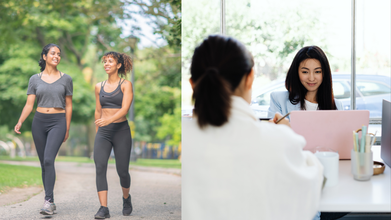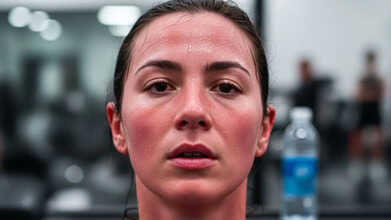- Health Conditions A-Z
- Health & Wellness
- Nutrition
- Fitness
- Health News
- Ayurveda
- Videos
- Medicine A-Z
- Parenting
10,000 Steps Cannot Undo The Damage Caused By A 9-Hour Desk Job, According To Doctor

Credits: Canva
For many people, completing a daily step goal feels like a sign of an active lifestyle. Fitness trackers, wellness challenges and social media trends have popularized the belief that 10,000 steps can undo the negative effects of long hours spent at a desk. However, vascular experts warn that this assumption is misleading. Prolonged sitting continues to damage the veins and circulation even if one walks later in the day.
Vascular Surgeon and Varicose Vein Specialist Dr Sumit Kapadia recently posted a video on his Instagram channel explaining why step counts alone cannot protect vascular health. He said this is something he tells his patients almost every day. Even if someone completes their step goal in the evening, the body has already endured hours of immobility that strain the veins.
According to Dr Kapadia, circulation does not depend on how much a person walks in total. Instead, it depends on how frequently they move. Long stretches of sitting from nine in the morning to seven in the evening cause blood to stagnate in the legs. This stagnation triggers a progressive cycle: vein valve weakness, swelling, varicose veins and, over time, an increased risk of developing blood clots.
Why Sitting for Long Hours Harms the Veins
When a person sits for too long, blood flow in the legs slows down. Veins must work harder to pump blood upward toward the heart, especially against gravity. The longer blood pools in the lower legs, the more pressure builds inside the veins. Over time, this weakens the valves that keep blood moving in the right direction.
Dr Kapadia explained that even a healthy step count cannot reverse ten hours of immobility. The veins experience stress and pressure throughout the day, and walking later does not undo the hours of stagnation already endured.
People with sedentary jobs, long commutes or limited movement throughout the day are especially at risk. Additional factors like being overweight, having a family history of venous disease, or standing for long hours without moving can worsen the impact.
Movement Frequency Matters More Than Step Count
According to Dr Kapadia, vascular health depends more on how often you move than how much you walk. The solution is not long-distance jogging or intense workouts after work, but small, consistent breaks during the day.
He offered a simple rule for preventing vein damage:
- Get up every 45 to 60 minutes.
- Stretch briefly to activate muscles.
- Walk for at least two minutes.
- Move your calf muscles, which act as the body’s “peripheral heart.”
Calf muscles play a major role in circulating blood back to the heart. When they contract, they push blood upward from the legs. But when they remain still for long periods, this pumping mechanism weakens. Small actions like ankle rotations, standing on tiptoes or short hallway walks can activate this pump and support vein health.
Small Breaks Make a Big Difference
Dr Kapadia emphasized that the veins do not need marathons. They need movement. Tiny breaks spread across the day help prevent swelling, heaviness, varicose veins and long-term complications such as deep vein thrombosis.
In a world where work, travel and digital life keep people sitting for most of the day, this message is more relevant than ever. Steps matter, but frequency matters far more. The key to healthy veins is simple: move often.
What Is Calisthenics? The Bodyweight Exercise Trending In The Fitness World

Credits: Canva
Strength training, also known as resistance training, involves working your muscles against some form of resistance, which helps them grow stronger and larger. It is an essential part of any fitness routine. While lifting weights is the most common form of strength training, there are several other ways to practice it.
One such method is calisthenics, which relies on your own body weight as resistance. Though both weightlifting and calisthenics fall under strength training, they produce different outcomes. Choosing the right one depends on your personal fitness objectives. Lately, calisthenics has been gaining renewed attention in the fitness world. Below, we break down what calisthenics is and whether it might be better for your workouts.
What Is Calisthenics?
Calisthenics is a workout style that primarily uses your body weight and often requires minimal or no equipment. Common calisthenics exercises include pushups, squats, crunches, planks, burpees, pullups, and lunges. These movements typically involve large muscle groups, like those used in pushups. Most people perform them at a moderate pace to improve coordination, flexibility, and overall strength. The practice of calisthenics dates back to Ancient Greece and continues to be popular today. It is accessible to people of all fitness levels, and many exercises don’t need any equipment at all.
How Effective Is Calisthenics?
Research indicates that calisthenics can improve everything from muscular strength to cardiovascular fitness, according to Anatolia Vick-Kregel, director of the Lifetime Physical Activity Program at Rice University. “Body weight is phenomenal,” she noted.
However, there are some limitations, said John Raglin, professor of kinesiology at the Indiana University School of Public Health, Bloomington. “It can be effective,” Raglin explained. “But thinking it can fully replace even simple equipment isn’t entirely correct.” Using equipment can sometimes make exercises easier or safer. Many people, for example, perform pushups with incorrect form. “If someone lacks strength or has joint problems or arthritis, lying on a bench and using light hand weights can be both safer and more practical,” he added.
Is Calisthenics Better Than Weightlifting?
Calisthenics tends to burn more calories, which can help reduce body fat and support weight loss. That’s because these exercises involve continuous movement, requiring more energy, which the body gets by burning calories. The higher the energy expenditure, the greater the potential for weight loss. Healthline notes that calisthenics can also be included in high-intensity workouts like HIIT or circuit training, further boosting calorie burn.
Weightlifting, on the other hand, focuses on isolated movements that don’t demand as much energy. Still, it contributes to weight management by increasing muscle mass, which raises your basal metabolic rate—the calories your body burns at rest.
Can You Combine Calisthenics And Weightlifting?
Combining the two methods is an excellent way to enjoy the benefits of both.
There are a few approaches to merging calisthenics with weightlifting:
- Same-day approach: Include both calisthenics and weightlifting exercises in one strength-training session.
- Alternate-day approach: Focus on one method per day, alternating between calisthenics and weightlifting throughout the week.
Since both forms provide resistance to your muscles, it’s important not to overdo it. Include rest days and listen to your body. For the best guidance on blending calisthenics and weightlifting, consult a personal trainer. They can tailor a program with the right exercises to suit your specific goals.
Delhiites, Skip Your Morning Walk, You May Be Inhaling 3x Toxic Air Than Usual, According To Doctor

Credits: PTI
As of November 19, 7am, Delhi's AQI as per the official data stands at 388, however, as per aqi.in, the average AQI of the city stands at 601 at 8.50 am. While there has been data discrepancies, as a result of which, people have come to street to protest against the continuous worsening air quality of the national capital. Amid this, Dr Manan Vora, a Mumbai-based orthopedic surgeon and sports doctor shared some tips to stay safe amid polluted air.
While watching a video of a person cleaning their clogged air purifier, Dr Vora says, "Your air purifiers can change filters but your lungs cannot," and suggests the following 5 tips:
Creation Of Clean Room
The first tip Dr Vora shares is to create a clean room, which can reduce exposure of pollutants by 60 to 70%. This could be achieved by an air purifier. He suggests everyone to decide one room in the house and shut its doors, and windows during peak hours, and turn on air purifier only in that room. "This alone curbs your exposure by 60 to 70%," he says.
Wear N-95 Mask
The doctor advises to wear an N-95 mask whenever someone is stepping outdoors. He mentions that a cloth or a surgical mask won't protect them against the pollutants, as N-95 masks are the only protective gears with filters that can keep the pollutants out when you breathe. "Only N-95 blocks the same particles clogging the purifier," he says, referring to a video of cleaning a clogged air purifier's filter.
Skip Morning Walks
"Skip your morning walks," he suggests. "AQI is highest at the sunrise and breathing rate triples while exercising. This means you inhale three times more pollution per minute," he says.
This happens because pollutants accumulate overnight, and without wind or sunlight, PM2.5 or the particulate matter stays trapped near the ground, leading to pollution being at its peak by sunrise. As per the data by aqi.in, highest AQI is always registered between 6am to 9am.
Use Wet Mop
Dr Vora suggests that while cleaning your house, instead of dry dusting, use a wet mop, this reduces dust particles. "Dry dusting pushes all the particles back into the air," he says.
Hydrate Your Self, Check On Your Check
The fifth tip he shares is to stay hydrated and consume vitamin C and other antioxidant-rich foods. As per the National Institutes of Health (NIH), US, vitamin C increases resistance to various viral and bacterial infections. A 2007 study published in the Journal of the Royal Society of Medicine noted that vitamin C or its supplement could in fact help patients with pneumonia or other lung-related disease. Thus vitamin C is a good boost for when lungs are at high risk, all thanks to the pollution.
The doctor also suggests the consumption of amla or Indian gooseberry and turmeric to boost your immunity. However, the doctor notes that while they do not cure pollution, but consuming these may reduce inflammation caused by pollutants.
"You cannot fix the AQI of your city, but you can control how much of it enters your body."
Why Does Your Face Turn Red After Working Out?

Credits: GEMINI
There is a certain satisfaction that comes after powering through a tough HIIT session. You expect that fresh, healthy glow at the end, but some people instead end up with a face that looks bright red, which can make them feel uneasy once they leave the gym.
To help you get back to your favourite spin class or running route without second thoughts, we turned to dermatologists to understand why this happens and how to calm it down. Here is what actually causes that red flush after exercise and what you can do to manage it.
Why Is My Face Turning Red After Doing Workout?
Your face often reddens during a workout because your body sends more blood to the skin and your temperature rises. The blood vessels on your face open wider to help release heat. It is simply your body cooling itself while supplying oxygen to the muscles that are working.
Vascular Changes Cause Flushing
The encouraging part is that a flushed face after working out is usually a normal part of how the body reacts to exertion. As your temperature rises, sweat helps cool you down, but your body also shifts blood flow and widens vessels near the surface of the skin. This can show up as a red or flushed look. Blair Murphy, MD, FAAD, a board-certified dermatologist in New York City, explains that this post-workout redness happens because the small blood vessels in the facial skin open up. The face tends to show it more clearly because it has many surface-level blood vessels.
People Prone To Flushing May Have More Superficial Capillaries
This kind of flushing appears in certain people simply because they have a greater number of capillaries near the surface. During exercise, your heart pumps faster to carry more oxygen to the muscles. The capillaries expand to move that oxygen efficiently while also carrying heat outward to help regulate temperature.
Your overall fitness level may also play a role. As blood flow increases, skin cells can release different substances in different individuals. Some may release prostaglandins, which add to the redness, while others may release histamines, which can also trigger flushing.
Flushing May Be More Noticeable In Fair Skin Tones
According to Arash Akhavan, MD, FAAD, a board-certified dermatologist in New York City, everyone experiences flushing during exercise, but it is more visible in people with lighter skin because deeper pigment in darker skin tones can hide mild redness. He also notes that some people naturally have a more extensive network of tiny blood vessels, making their skin appear redder after exertion.
How To Prevent Facial Flushing?
Opt for lightweight clothing: You cannot completely stop redness during exercise, but you can take simple steps to reduce it. Try working out in a cooler setting and wear loose, light-coloured clothing to help your body regulate heat.
Avoid alcohol and excessive sun exposure: If your skin already flushes easily, alcohol before a workout is not a good idea. Corey L. Hartman, MD, board-certified dermatologist and founder of Skin Wellness Dermatology, explains that alcohol widens blood vessels and increases facial redness. Too much sun can also irritate the skin and make surface capillaries more visible by causing them to dilate.
Stay away from potentially irritating skincare: Those who flush often or have rosacea should avoid skincare that can irritate the skin further, including alcohol-heavy products, highly acidic creams, or strong retinoids. Dr. Akhavan recommends choosing calming, non-irritating products with ingredients like hyaluronic acid, vitamin C, and niacinamide.
Vitamin C is especially helpful because it protects the skin from oxidative stress and helps shield against UVA and UVB rays, which can intensify redness. Fragrance should also be avoided since it can trigger irritation and increase flushing.
© 2024 Bennett, Coleman & Company Limited

